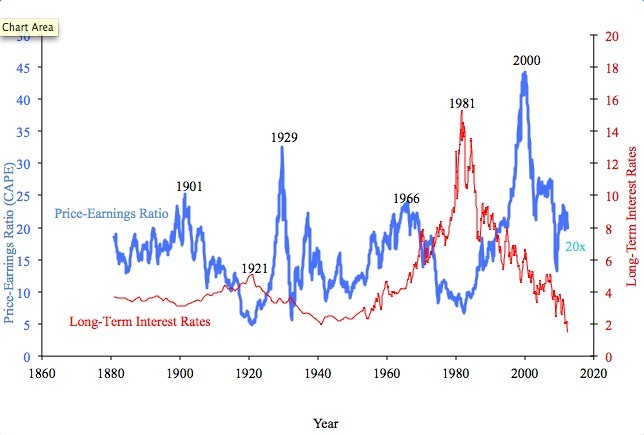Cyclically adjusted pricetoearnings ratio Wikipedia the free encyclopedia
Post on: 15 Июль, 2015 No Comment

Contents
Background [ edit ]
Value investors Benjamin Graham and David Dodd argued for smoothing a firm’s earnings over the past five to ten years in their classic text Security Analysis . Graham and Dodd noted one-year earnings were too volatile to offer a good idea of a firm’s true earning power. In a 1988 paper [ 5 ] economists John Y. Campbell and Robert Shiller concluded that a long moving average of real earnings helps to forecast future real dividends which in turn are correlated with returns on stocks. The idea is to take a long-term average of earnings (typically 5 or 10 year) and adjust for inflation to forecast future returns. The long term average smooths out short term volatility of earnings and medium-term business cycles in the general economy and they thought it was a better reflection of a firm’s long term earning power.
Shiller later popularized the 10-year version of Graham and Dodd’s P/E as a way to value the stock market. [ 2 ] [ 6 ] Shiller would share the Nobel prize in 2013 for his work in the empirical analysis of asset prices.
Use in forecasting future returns [ edit ]
Using market data from both estimated (1881 — 1956) and actual (1957 onward) earnings reports from the S&P index, Shiller and Campbell found that the lower the CAPE, the higher the investors likely return from equities over the following 20 years. The average CAPE value for the 20th century was 15.21; this corresponds to an average annual return over the next 20 years of around 6.6 per cent. CAPE values above this produce corresponding lower returns, and vice versa. In 2014, Shiller expressed concern that the prevailing CAPE of over 25 was a level that has been surpassed since 1881 in only three previous periods: the years clustered around 1929, 1999 and 2007. Major market drops followed those peaks (ref 4).
However, Shiller’s views have been criticised as overly pessimistic and based on the original definition of CAPE, which fails to take into account recent changes in the way earnings are calculated under accountancy rules; an analysis by Jeremy Siegel suggests that once the resulting bias is accounted for, the CAPE is shown to underestimate likely equity returns. [ 7 ]

The measure exhibits a significant amount of variation over time, and has been criticised as not always accurate in signaling market tops or bottoms.. [ 2 ] One proposed reason for this time variation is that CAPE does not take into accounts prevailing risk free interest rates. A common debate is whether the inverse CAPE ratio should be further divided by the yield on 10 year Treasuries. [ 8 ] This debate regained currency in 2014 as the CAPE ratio reached an all time high in combination with historically very low rates on 10 year Treasuries.
A high CAPE ratio has been linked to the phrase Irrational exuberance and to Shiller’s book of the same name. After Fed President Alan Greenspan coined the term in 1996, the CAPE ratio reached an all-time high during the 2000 dot-com bubble. It also reached an historically high level again during the housing bubble up to 2007 before the crash of the great recession. [ 9 ]
CAPE for other equity markets [ edit ]
Originally derived for the US equity market, the CAPE has since been calculated for 15 other markets. [ 10 ] Research by Norbert Keimling has demonstrated that the same relation between CAPE and future equity returns exists in every equity market so far examined. [ 11 ] It also suggests that comparison of CAPE values can assist in identifying the best markets for future equity returns beyond the US S&P.














